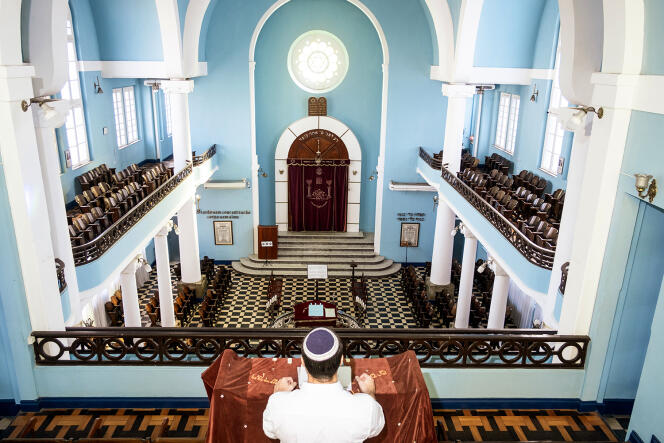


The vast, azure blue building can be reached via a narrow street away from downtown Belém. Unlike so many other historic buildings in the capital of the state of Pará, at the mouth of the Amazon, this one has hardly suffered the ravaging effects of time and extreme humidity. Quite the opposite: Perfectly maintained, the Sha'ar Hashamayim synagogue looks like it could have been inaugurated yesterday.
Jews in the Amazon? As ancient as it is little known, the community has seen its peace disturbed since the start of the war in Gaza between Israel and Hamas, on October 7. Inaugurated in 1826 or 1828 (the date is debated), Sha'ar Hashamayim is considered to be the very first synagogue built in Brazil after independence in 1822. With its dome, pearly white pillars and silver oil lamps, the 200-year-old place of worship retains a touch of the Orient.
"Its architecture is typically Sephardic-Moorish," said its friendly 44-year-old president, Samuel Gabbay. The Amazon is nevertheless present in the chairs and flooring, all crafted from tropical jatobá wood. The stained glass windows, in shades of green and yellow, evoke the colors of the great forest. "We regularly receive tourists from Europe and Israel who are very curious about our synagogue," explained Gabbay.
And yet Jews are but a drop in the jungle-green ocean. They number no more than 5,000 of the 17 million inhabitants of the Brazilian Amazon (a mere 0.02% of the population), mostly clustered in the metropolises of Belém and Manaus. Unlike the other 120,000 Jews in Brazil, the majority of whom are Ashkenazi, they are almost entirely Sephardic and of Moroccan origin.
Their arrival in the Portuguese colony officially dates back to 1810. "Three years earlier, Napoleon invaded Portugal, and the Portuguese Braganza royal family fled to Rio under British protection. In exchange, the English obtained the right for foreigners to trade freely in the colony," recounted Anne Benchimol, a Manaus-born Jewish historian and keeper of the community's memory. "Moroccan Jews saw this as an economic opportunity. Some left for the Amazon," she explained.
Migration increased from 1850 onward, with the famous "rubber boom." Well educated and multilingual, Jews from Fez and Tangiers served as intermediaries between local producers and European traders. They participated in the development of Belém and Manaus, and they founded synagogues, schools and newspapers. Some members entered politics, such as Eliezer Levy, who became mayor of Macapá, a large city on the Amazon Delta, in the 1930s.
You have 49.78% of this article left to read. The rest is for subscribers only.
